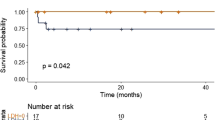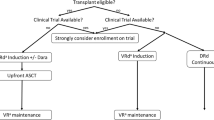Abstract
The prognostic value of chromosomal 1q21 gain in newly diagnosed multiple myeloma (NDMM) remains controversial. Add-on Myc aberrations may further worsen the outcome. To investigate whether specific genes located at the 1q21 region, such as myeloid cell leukemia 1 (Mcl-1), are involved in NDMM progression, we examined bone marrow cytogenetic abnormalities in 153 patients with NDMM by fluorescence in situ hybridization. Their response to treatment and survival was also analyzed. C-Myc and Mcl-1 expressions in bone marrow samples were analyzed by RT-PCR. The expression of Mcl-1 was evaluated in bone marrow sections by immunohistochemistry. MM cell lines were transfected with Mcl-1 siRNA. 1q21 gain was present in 55/153 (35.9%) patients and strongly associated with Myc rearrangement (31/153, 20.3%, P = 0.004). A positive correlation was observed between Myc and Mcl-1 mRNA levels in bone marrow cells from 47 patients (r = 0.57, P < 0.001). The combination of 1q21 gain and Myc rearrangement was associated with poorer overall survival than Myc rearrangement alone (16.8 vs. 27.9 months, P = 0.077) or 1q21 gain alone (16.8 vs. 60.7 months, P < 0.01). High Mcl-1 protein expression in bone marrow plasma cells was associated with Myc rearrangement. Mcl-1 silencing by siRNA inhibited Myc protein expression in three myeloma cell lines. Treatment with the small-molecule Mcl-1 inhibitor, UMI-77, produced similar results. Overall, the combination of Myc rearrangement and 1q21 gain was associated with particularly poor prognosis in patients with MM. Furthermore, our data are consistent with Mcl-1-dependent Myc protein activation.





Similar content being viewed by others
Abbreviations
- EMD:
-
extramedullary disease
- FISH:
-
fluorescence in situ hybridization
- IMWG:
-
International Myeloma Working Group
- ISS:
-
International Staging System
- LDH:
-
elevated lactic dehydrogenase
- Mcl-1:
-
myeloid cell leukemia 1
- MM:
-
multiple myeloma
- MNCs:
-
mononuclear cells
- NDMM:
-
newly diagnosed MM
- OS:
-
overall survival.
References
Kumar SK, Rajkumar SV (2018) The multiple myelomas - current concepts in cytogenetic classification and therapy. Nat Rev Clin Oncol 15(7):409–421
Palumbo A, Anderson K (2011) Multiple myeloma. N Engl J Med 364(11):1046–1060
McCarthy PL, Holstein SA, Petrucci MT et al (2017) Lenalidomide maintenance after autologous stem-cell transplantation in newly diagnosed multiple myeloma: a meta-analysis. J Clin Oncol 35(29):3279–3289
Sonneveld P, Avet-Loiseau H, Lonial S, Usmani S, Siegel D, Anderson KC, Chng WJ, Moreau P, Attal M, Kyle RA, Caers J, Hillengass J, San Miguel J, van de Donk NWCJ, Einsele H, Bladé J, Durie BGM, Goldschmidt H, Mateos MV, Palumbo A, Orlowski R (2016) Treatment of multiple myeloma with high-risk cytogenetics: a consensus of the International Myeloma Working Group. Blood. 127(24):2955–2962
Greipp PR, San Miguel J, Durie BG et al (2005) International staging system for multiple myeloma. J Clin Oncol 23(15):3412–3420
Avigan D, Rosenblatt J (2014) Current treatment for multiple myeloma. N Engl J Med 371:961–962
Chng WJ, Dispenzieri A, Chim CS et al (2014) IMWG consensus on risk stratification in multiple myeloma. Leukemia. 28(2):269–277
Mikhael JR, Dingli D, Roy V, Reeder CB, Buadi FK, Hayman SR, Dispenzieri A, Fonseca R, Sher T, Kyle RA, Lin Y, Russell SJ, Kumar S, Bergsagel PL, Zeldenrust SR, Leung N, Drake MT, Kapoor P, Ansell SM, Witzig TE, Lust JA, Dalton RJ, Gertz MA, Stewart AK, Rajkumar SV, Chanan-Khan A, Lacy MQ, Mayo Clinic (2013) Management of newly diagnosed symptomatic multiple myeloma: updated Mayo Stratification of Myeloma and Risk-Adapted Therapy (mSMART) consensus guidelines 2013. Mayo Clin Proc 88(4):360–376
Lopez-Anglada L, Gutierrez NC, Garcia JL et al (2010) P53 deletion may drive the clinical evolution and treatment response in multiple myeloma. Eur J Haematol 84(4):359–361
Palumbo A, Avet-Loiseau H, Oliva S, Lokhorst HM, Goldschmidt H, Rosinol L, Richardson P, Caltagirone S, Lahuerta JJ, Facon T, Bringhen S, Gay F, Attal M, Passera R, Spencer A, Offidani M, Kumar S, Musto P, Lonial S, Petrucci MT, Orlowski RZ, Zamagni E, Morgan G, Dimopoulos MA, Durie BGM, Anderson KC, Sonneveld P, San Miguel J, Cavo M, Rajkumar SV, Moreau P (2015) Revised international staging system for multiple myeloma: a report From International Myeloma Working Group. J Clin Oncol 33(26):2863–2869
An G, Xu Y, Shi L, Shizhen Z, Deng S, Xie Z, Sui W, Zhan F, Qiu L (2014) Chromosome 1q21 gains confer inferior outcomes in multiple myeloma treated with bortezomib but copy number variation and percentage of plasma cells involved have no additional prognostic value. Haematologica. 99(2):353–359
Chng WJ, Huang GF, Chung TH, Ng SB, Gonzalez-Paz N, Troska-Price T, Mulligan G, Chesi M, Bergsagel PL, Fonseca R (2011) Clinical and biological implications of MYC activation: a common difference between MGUS and newly diagnosed multiple myeloma. Leukemia. 25(6):1026–1035
Delgado MD, Leon J (2010) Myc roles in hematopoiesis and leukemia. Genes Cancer 1(6):605–616
Chen H, Liu H, Qing G (2018) Targeting oncogenic Myc as a strategy for cancer treatment. Signal Transduct Target Ther 3:5
Campbell KJ, Bath ML, Turner ML, Vandenberg CJ, Bouillet P, Metcalf D, Scott CL, Cory S (2010) Elevated Mcl-1 perturbs lymphopoiesis, promotes transformation of hematopoietic stem/progenitor cells, and enhances drug resistance. Blood. 116(17):3197–3207
Dang CV (2012) MYC on the path to cancer. Cell. 149(1):22–35
Jia Y, Chng WJ, Zhou J (2019) Super-enhancers: critical roles and therapeutic targets in hematologic malignancies. J Hematol Oncol 12(1):77
International Myeloma Working Group (2003) Criteria for the classification of monoclonal gammopathies, multiple myeloma and related disorders: a report of the International Myeloma Working Group. Br J Haematol 121(5):749–757
Rack KA, van den Berg E, Haferlach C, Beverloo HB, Costa D, Espinet B, Foot N, Jeffries S, Martin K, O’Connor S, Schoumans J, Talley P, Telford N, Stioui S, Zemanova Z, Hastings RJ (2019) European recommendations and quality assurance for cytogenomic analysis of haematological neoplasms. Leukemia. 33(8):1851–1867
Abulwerdi F, Liao C, Liu M, Azmi AS, Aboukameel A, Mady ASA, Gulappa T, Cierpicki T, Owens S, Zhang T, Sun D, Stuckey JA, Mohammad RM, Nikolovska-Coleska Z (2014) A novel small-molecule inhibitor of mcl-1 blocks pancreatic cancer growth in vitro and in vivo. Mol Cancer Ther 13(3):565–575
Affer M, Chesi M, Chen WD, Keats JJ, Demchenko YN, Tamizhmani K, Garbitt VM, Riggs DL, Brents LA, Roschke AV, van Wier S, Fonseca R, Bergsagel PL, Kuehl WM (2014) Promiscuous MYC locus rearrangements hijack enhancers but mostly super-enhancers to dysregulate MYC expression in multiple myeloma. Leukemia. 28(8):1725–1735
Walker BA, Wardell CP, Murison A, Boyle EM, Begum DB, Dahir NM, Proszek PZ, Melchor L, Pawlyn C, Kaiser MF, Johnson DC, Qiang YW, Jones JR, Cairns DA, Gregory WM, Owen RG, Cook G, Drayson MT, Jackson GH, Davies FE, Morgan GJ (2015) APOBEC family mutational signatures are associated with poor prognosis translocations in multiple myeloma. Nat Commun 6:6997
Avet-Loiseau H, Gerson F, Magrangeas F, Minvielle S, Harousseau JL, Bataille R, Intergroupe Francophone du Myélome (2001) Rearrangements of the c-myc oncogene are present in 15% of primary human multiple myeloma tumors. Blood. 98(10):3082–3086
Boyd KD, Ross FM, Chiecchio L et al (2012) A novel prognostic model in myeloma based on co-segregating adverse FISH lesions and the ISS: analysis of patients treated in the MRC Myeloma IX trial. Leukemia. 26(2):349–355
Zhuang J, Da Y, Li H et al (2014) Cytogenetic and clinical risk factors for assessment of ultra high-risk multiple myeloma. Leuk Res 38(2):188–193
Ji M, Jang S, Lee JH, Seo EJ (2013) Double-hit myeloma with IGH/MYC and IGH/CCND1 translocations. Ann Hematol 92(8):1129–1131
Shah V, Sherborne AL, Walker BA et al (2018) Prediction of outcome in newly diagnosed myeloma: a meta-analysis of the molecular profiles of 1905 trial patients. Leukemia. 32(1):102–110
Merz M, Jauch A, Hielscher T, Bochtler T, Schönland SO, Seckinger A, Hose D, Bertsch U, Neben K, Raab MS, Hillengass J, Salwender H, Blau IW, Lindemann HW, Schmidt-Wolf IGH, Scheid C, Haenel M, Weisel KC, Goldschmidt H (2018) Prognostic significance of cytogenetic heterogeneity in patients with newly diagnosed multiple myeloma. Blood Adv 2(1):1–9
Walker BA, Mavrommatis K, Wardell CP, Ashby TC, Bauer M, Davies F, Rosenthal A, Wang H, Qu P, Hoering A, Samur M, Towfic F, Ortiz M, Flynt E, Yu Z, Yang Z, Rozelle D, Obenauer J, Trotter M, Auclair D, Keats J, Bolli N, Fulciniti M, Szalat R, Moreau P, Durie B, Stewart AK, Goldschmidt H, Raab MS, Einsele H, Sonneveld P, San Miguel J, Lonial S, Jackson GH, Anderson KC, Avet-Loiseau H, Munshi N, Thakurta A, Morgan G (2018) A high-risk, double-hit, group of newly diagnosed myeloma identified by genomic analysis. Leukemia. 33(1):159–170
Weinhold N, Ashby C, Rasche L, Chavan SS, Stein C, Stephens OW, Tytarenko R, Bauer MA, Meissner T, Deshpande S, Patel PH, Buzder T, Molnar G, Peterson EA, van Rhee F, Zangari M, Thanendrarajan S, Schinke C, Tian E, Epstein J, Barlogie B, Davies FE, Heuck CJ, Walker BA, Morgan GJ (2016) Clonal selection and double-hit events involving tumor suppressor genes underlie relapse in myeloma. Blood. 128(13):1735–1744
Wuilleme-Toumi S, Robillard N, Gomez P et al (2005) Mcl-1 is overexpressed in multiple myeloma and associated with relapse and shorter survival. Leukemia. 19(7):1248–1252
Acknowledgments
We acknowledge the assistance of the Department of Pathology, Peking Union Medical College Hospital, for the preparation of bone marrow sections.
Funding
This work was supported by the Natural Science Funds of the Beijing Municipality [No 7192175] and the CAMS Initiative for Innovative Medicine [Grant Nos. 2016-I2M-3-025].
Author information
Authors and Affiliations
Contributions
Y.J. and X.Y. contributed equally to this article as first authors, wrote the article, and analyzed the clinical and experimental data. Y.Z. isolated the PBMCs from the bone marrow. H.L. contributed to the FISH experiments. W.T. contributed to patients’ follow-up. C.J. stained bone marrow slides and trained Y.J., M.Y., and Y.Z. collected the clinical data. W.R. was involved in statistical analysis. D.Z. and M.C. participated in manuscript preparation and revision. J.Z. is the corresponding author and contributed to the study design. All authors read and approved the final manuscript.
Corresponding author
Ethics declarations
Ethics approval and consent to participate
All human samples were obtained in accordance with the guidelines of the Ethics Committee of the Peking Union Medical College Hospital & Chinese Academy of Medical Sciences & Peking Union Medical College.
Conflict of interest
The authors declare no competing interests.
Additional information
Publisher’s note
Springer Nature remains neutral with regard to jurisdictional claims in published maps and institutional affiliations.
Rights and permissions
About this article
Cite this article
Jin, Y., Yu, X., Du, J. et al. The combination of C-Myc rearrangement and 1q21 gain is associated with poor prognosis in multiple myeloma. Ann Hematol 100, 1251–1260 (2021). https://doi.org/10.1007/s00277-021-04475-2
Received:
Accepted:
Published:
Issue Date:
DOI: https://doi.org/10.1007/s00277-021-04475-2




